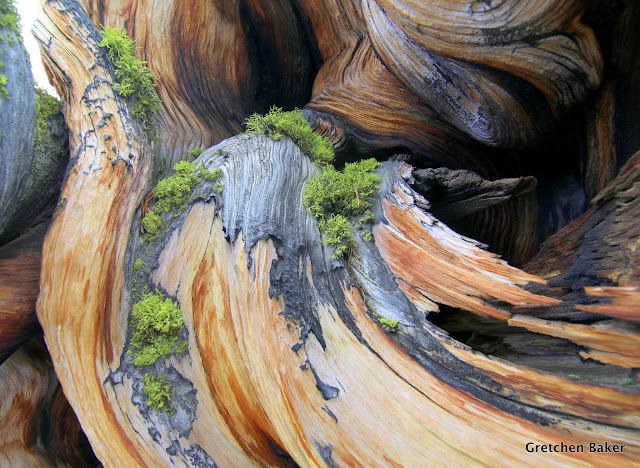See Part 1 of the Tour of Great Basin National Park's Bristlecone Pine Groves.
The easiest bristlecone pine grove to access in Great Basin National Park is the Wheeler cirque bristlecone grove. It's located below the stunning 13,063 ft Wheeler Peak. One of the things that makes this grove stand out is that the bristlecone pines are growing on quartzite rock (instead of the usual limestone or dolomite) and on glacial moraines that have only been uncovered by ice for 10,000 years or so.
To get there, you drive to the end of the Wheeler Peak Scenic Drive and then take a 1.5 mile trail to the bristlecones. It's a fairly easy trail, but because it's over 10,000 feet elevation, you might find yourself gasping in the thin air! It's also only accessible from June to October unless you want to snow shoe or ski from Upper Lehman Campground, as during the winter the road is closed at that point.
On the trail there, you start passing some bristlecone pines before the interpretive trail with signs. This dead tree shows the twisted skeleton of a formerly majestic tree.
Even when dead, the bristlecone pines persevere on the landscape for a long time, their dense wood resisting erosion, wind, sun, and other factors that would break down other wood. In some cases, the trees even become home to lichens.
Bristlecone pines are five-needle pines, meaning that their pine needles grow in clumps of five. One of the easiest ways to identify them is to look for the signature bottle-brush drooping of the branches. The needles are grouped densely.
Looking up at the bristlecone pines also shows off the bottle-brush look. It also showcases that many of the bristlecone pines are only partly alive. There are sections of dead wood and live tree on many of the trees. The reason this exists is because of stripbarking. Where strips of bark still exist, water and nutrients can be delivered to the pine needles, and that part of the tree continues to live. Where the bark has fallen away, that section of the tree is dead.
The start of the interpretive trail begins with a sign about the grove. There's also a convenient bench if you want to sit a moment to catch your breath or absorb the magic of these ancient trees.
As you walk along the short trail, signs share some information about the bristlecones, such as how they are dated, how they grow, and what some threats to their existence are (we'll get into all those topics in this series).
Several of the trees in this grove are over 3,000 years old. That's sort of mind boggling that they started growing well before what we call year 1.
There was one tree not far from this area that turned out to be much older. In the 1960s, a graduate student doing research in the national forest (Great Basin National Park was established in 1986) used an increment borer to get a small straw-sized amount of tree core out so he could date it. The increment borer got stuck, so after hiking all the way down (there was no scenic drive at the time), he got permission from the US Forest Service to cut the tree to get his increment borer out. When he did, he found that the tree was estimated to be about 5,000 years old! No other tree in the area has been found to be that old, or even over 4,000 years old for that matter. You can read more about the
Prometheus story here. Bristlecone pines were awarded more protection after that.
Visiting the bristlecone pines is one of the top visitor activities in Great Basin National Park. There is just something special about seeing these trees that have survived so long through all sorts of storms, droughts, blizzards, scorching sun, and more.
The background of tall mountains and cliffs make for spectacular scenery.
Just thinking about the bristlecones energizes me in a way that other tree species doesn't quite do.
During Covid, Comet Neowise appeared in the night skies. I wanted to capture the comet with epic scenery, so met up with a couple friends to go this spot (for two nights, since the first night didn't work out!). Perhaps these bristlecones were alive the last time Comet Neowise made an appearance.
Stay tuned for more posts about bristlecone pines in less visited areas of the Park!





















-Enhanced.jpg)















































